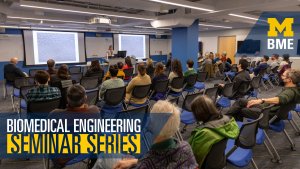Presented By: Biomedical Engineering
Biomechanics of the Femoropopliteal Artery in the Lower Limb
Biomedical Engineering (BME 500) Seminar Series - Alexey Kamenskiy, PhD

Abstract:
Despite years of technological and pharmacological improvements, failure rates remain high for the lower extremity peripheral arterial disease repairs, particularly when the repair devices cross the knee joint. Though much work has been done investigating the pathological processes associated with this failure, the underlying mechanisms remain insufficiently understood. The main arterial segment within the leg, the femoropopliteal artery, appears to be significantly different from other peripheral arteries due to lower blood flow and large deformations experienced during flexion of the limbs. Understanding the magnitude of these deformations in different postures and arterial segments may help improve repair devices through benchtop and computational studies of device-artery interactions. These studies rely on comprehensive assessments of arterial mechanics and structure and call for innovative ways of accounting for patient demographics and risk factors to deliver realistic results. We will summarize our findings related to the quantification of the biomechanical environment of the lower limb arteries, describe their structure and mechanical properties in the context of age and disease, present in vitro and computational frameworks to evaluate device-artery interactions, and introduce a preclinical animal model to assess the performance of new endovascular and open surgical repairs for the lower extremity.
Bio:
Dr. Kamenskiy earned his Ph.D. in Engineering Mechanics from the University of Nebraska-Lincoln, and started his academic career as an Assistant Professor in the Department of Surgery at the University of Nebraska Medical Center. After advancing through the academic ranks and receiving tenure in Surgery, Dr. Kamenskiy joined the Department of Biomechanics at the University of Nebraska at Omaha, where he currently serves as Department Chair. In his research, Dr. Kamenskiy integrates Biomechanics and Medicine using in vivo, ex vivo, in vitro, and in silico methods. His lab is interested in vascular mechanophysiology, mechanobiology, and aging and closely collaborates with vascular surgeon-scientists who share the goal of developing practical solutions to improve clinical outcomes for vascular disease patients. Dr. Kamenskiy has assembled one of the largest databases of human artery mechanical, structural, and demographic characteristics that includes well over 1,000 specimens 12 to 99 years old. This database is a unique resource for understanding the complex and diverse pathology of human blood vessels. In addition to studying ex vivo arteries, the team of Dr. Kamenskiy also utilizes cell and organ culture systems and large animal models to explore the disease pathways they observe in human tissues. This research is accompanied by designing, modeling, and testing of new vascular and endovascular repair materials and devices for various vascular pathologies and trauma that his team carries out using bench-top, porcine, human cadaver, and clinical experiments.
Zoom:
https://umich.zoom.us/j/91712262512
Despite years of technological and pharmacological improvements, failure rates remain high for the lower extremity peripheral arterial disease repairs, particularly when the repair devices cross the knee joint. Though much work has been done investigating the pathological processes associated with this failure, the underlying mechanisms remain insufficiently understood. The main arterial segment within the leg, the femoropopliteal artery, appears to be significantly different from other peripheral arteries due to lower blood flow and large deformations experienced during flexion of the limbs. Understanding the magnitude of these deformations in different postures and arterial segments may help improve repair devices through benchtop and computational studies of device-artery interactions. These studies rely on comprehensive assessments of arterial mechanics and structure and call for innovative ways of accounting for patient demographics and risk factors to deliver realistic results. We will summarize our findings related to the quantification of the biomechanical environment of the lower limb arteries, describe their structure and mechanical properties in the context of age and disease, present in vitro and computational frameworks to evaluate device-artery interactions, and introduce a preclinical animal model to assess the performance of new endovascular and open surgical repairs for the lower extremity.
Bio:
Dr. Kamenskiy earned his Ph.D. in Engineering Mechanics from the University of Nebraska-Lincoln, and started his academic career as an Assistant Professor in the Department of Surgery at the University of Nebraska Medical Center. After advancing through the academic ranks and receiving tenure in Surgery, Dr. Kamenskiy joined the Department of Biomechanics at the University of Nebraska at Omaha, where he currently serves as Department Chair. In his research, Dr. Kamenskiy integrates Biomechanics and Medicine using in vivo, ex vivo, in vitro, and in silico methods. His lab is interested in vascular mechanophysiology, mechanobiology, and aging and closely collaborates with vascular surgeon-scientists who share the goal of developing practical solutions to improve clinical outcomes for vascular disease patients. Dr. Kamenskiy has assembled one of the largest databases of human artery mechanical, structural, and demographic characteristics that includes well over 1,000 specimens 12 to 99 years old. This database is a unique resource for understanding the complex and diverse pathology of human blood vessels. In addition to studying ex vivo arteries, the team of Dr. Kamenskiy also utilizes cell and organ culture systems and large animal models to explore the disease pathways they observe in human tissues. This research is accompanied by designing, modeling, and testing of new vascular and endovascular repair materials and devices for various vascular pathologies and trauma that his team carries out using bench-top, porcine, human cadaver, and clinical experiments.
Zoom:
https://umich.zoom.us/j/91712262512